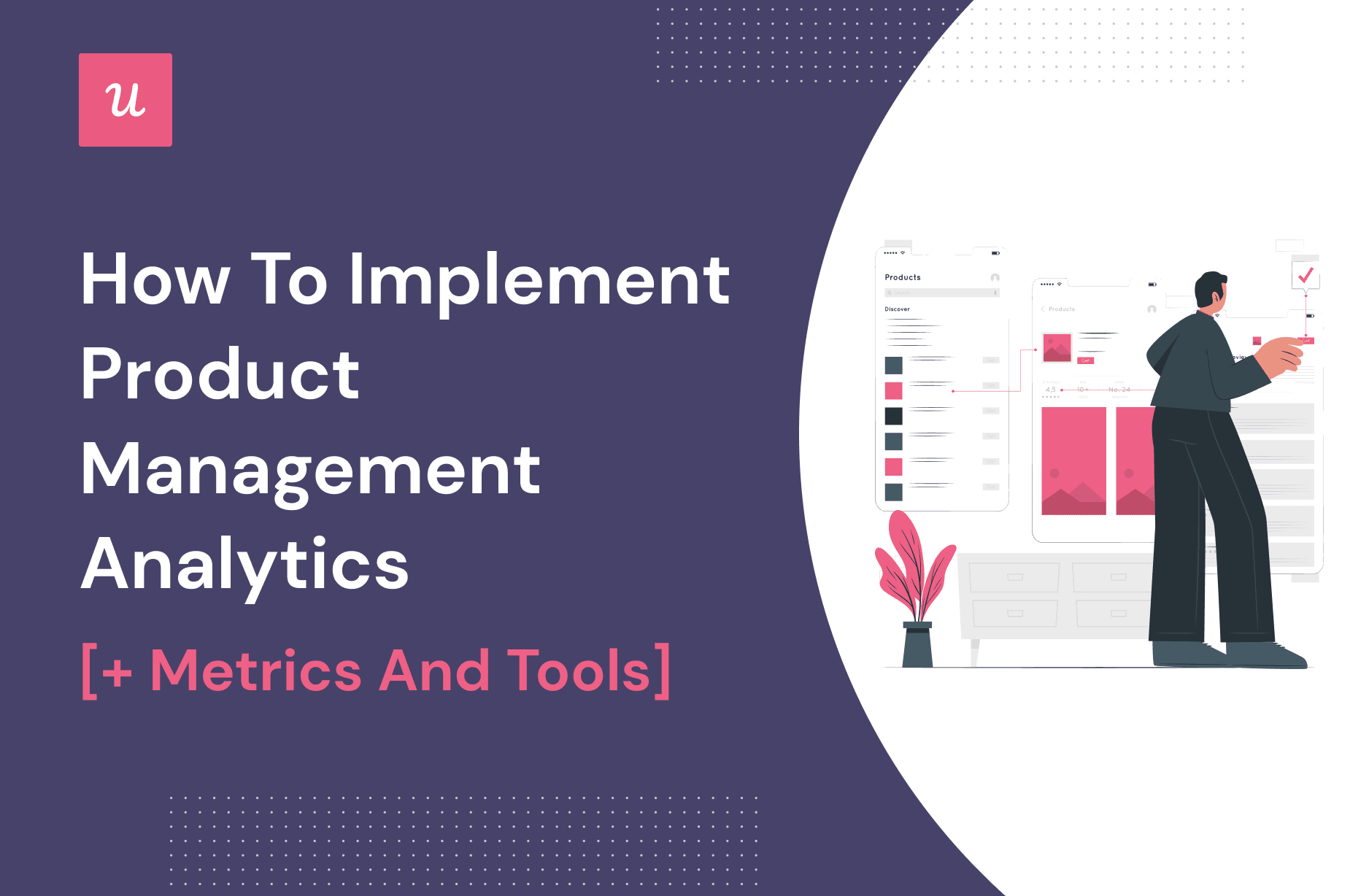
How to Implement Product Management Analytics [+ Metrics and Tools]
Do you implement product management analytics from the onset of a product launch to understand user behavior and timely improve the product based on the findings?
If so, where should you begin? What metrics should you track to turn them into actionable insights?
This piece will guide you through all the crucial steps of product analytics, from finding important customer data to using various product management analytics tools.
Ready to dive into product management analytics? Let’s get started!
Get The Insights!
The fastest way to learn about Product Growth, Management & Trends.
TL;DR
- Product management analytics revolves around the understanding of user behavior across your product. Through collecting and analyzing user data, it gives you insights into what users do inside your product and for how often.
- Multiple teams need to gauge product analytics data. Product managers — for making data-driven decisions. Product marketers — for identifying new opportunities.
- Customer success teams — for understanding customers’ needs. UX designers and developers — for making improvements to the product.
- Common product management metrics to track enlist:
– Engagement metrics (Average Daily Active Users, NPS score, product adoption rate, and product stickiness)
– Conversion metrics (visitor to sign up, trial to paid conversion rate, Marketing Qualified Leads to Sales Qualified Leads conversion rate, Product Qualified Leads to Sales Qualified Leads conversion rate)
– Retention metrics (retention rate, Customer Lifetime Value, Monthly Recurring Revenue, churn rate) - For analyzing data and gain insights into product performance, you can carry out product data analyses as follows:
– Segmenting users based on specific user and behavioral characteristics (customer behavioral segmentation);
– Conducting cohort analysis to detect user behavior changes among different user groups over a defined period, like churn behaviors;
– Setting up funnel analysis to find out conversion and drop-off points;
– Carrying out retention analysis to understand how and why users churn. - Choose Mixpanel if you want to analyze both your site and your product. Track each step of how users progress through the customer journey from different traffic sources (e.g., social media and organic traffic).
- Amplitude will help you with behavioral reports to understand user engagement within your product.
- You can use Userpilot to collect and analyze data using a wide range of analytics features such as segmentation, funnels, trends, features and events analytics, etc. Book a demo to see how Userpilot helps you understand user behavior and improve your product.
Try Userpilot for Collecting and Analyzing User Behavior Data!

What is product management analytics?
Product management analytics revolves around the understanding of user behavior across your product.
By leveraging product analytics, product managers can uncover improvement opportunities, whether it’s a clunky interface, confusing features, or bottlenecks in the user journey. Simultaneously, it also gives insights into what delights and engages users, fostering their loyalty and advocacy.
Why are product management analytics important?
By performing product data analysis, product managers can understand changes in user behavior and preferences, which is crucial for driving product success and organizational growth. Here are some use cases where product management analytics hold such significance:
- Analytics allows you to formulate strategies based on real user data, making decisions more precise and effective. For example, feedback data analytics might reveal that a specific feature is difficult to use, and you can create a strategy that includes redesigning the feature, enhancing user documentation, and providing additional in-app guidance.
- Understanding user behavior through analytics helps you build customer loyalty through the identification of factors that contribute to customer satisfaction and engagement.
- Product management analytics help identify potential upsell opportunities. For instance, if analytics indicate that a customer is using a limited set of features but could benefit from more advanced ones, you can engage with them to encourage upgrades using in-app messages.

Who needs product management analytics?
Almost every department in SaaS businesses needs to access product analytics data. Product managers and data scientists convert collected metrics to product improvements. In turn, product marketers make use of product data to understand customer pain points and address product features as a solution.
Other departments also use data analytics to hone the overall customer experience.
At this point, let’s get more granular and learn how different roles act on product data.
- Product managers — for making strategic decisions: Product managers leverage product data to prioritize features, align the roadmap with user needs, optimize user experience, conduct A/B tests, and iteratively enhance the product.
- Product marketers — for identifying new opportunities: Product marketing teams can use product analytics to identify trends and customize messaging based on popular features, refine positioning, and optimize pre-onboarding to increase conversion rates
- Customer success teams — for understanding customers’ needs: They can use product management analytics to see how users behave in the app and what they do. They can use that data to understand customers on a deeper level to timely offer help to increase customer lifetime value, customer loyalty, or upgrade/upsell a user.
- UX designers and developers — for making improvements to the product: UX/UI designers can use different product analytics tools to observe how users engage with the product and what areas of the interface they consider insufficient.
Important product management analytics metrics
Now that we know how beneficial product data analytics is for the overall product strategy and business growth, let’s learn what common metrics product managers have to track except OKRs and KPIs to make a real impact on the business performance.
Engagement metrics
Does your product help get the job done? What percentage of active users becomes selected or paid customers? Engagement metrics are key performance indicators providing insights into how many users actually use your product and derive value from it.
- Average daily active users (ADAU): This metric tells you how many users engage with your product on a given day. If there’s stagnation (or worse — a drop), you have to immediately take action and find out what caused the leak to be able to patch it up.
- Product stickiness will tell you for how long customers stay with your product from day one and engage with it so that you can gauge the likeability of your product.
- Product adoption rate the product adoption rate can reveal how engaged users are with the product. A sustained or increasing adoption rate indicates that users continue to find value in the product and are incorporating it into their regular activities.
- Net Promoter Score (NPS) is quantitative data indicating customer satisfaction levels at different customer journey stages. You can measure NPS of a particular feature or the overall experience with your product, company, or customer support.
Conversion metrics
SaaS conversion metrics tell you whether your current product marketing strategy and onboarding process are up to par.
- The visitor to sign up: Gauge this data to understand what percentage of monthly visitors converts to new signups. A benchmark for SaaS companies lies between 2% to 5%.
- Trial to paid conversion rate: Product managers must track this metric because it is crucial to the business. The trial to paid conversion rate is the number of people who decided to buy the product after trying it. In the B2B sector, the industry average is between 14-25%. Product teams can improve this by honing onboarding and the overall user experience across the product.
- MQL to SQL conversion rate: The MQL to SQL conversion rate is the percent of marketing qualified leads that become sales qualified leads.
- PQL to SQL conversion rate: PQL to SQL conversion rate refers to existing free trial or freemium users who have adopted some features and may likely become paying customers.
Retention metrics
SaaS customer retention metrics are one of the essential business metrics in product analytics to keep an eye on. They explicitly describe how healthy your business is and for how long you will remain profitable.
- Retention rate is the percentage of users you retain over a period of time. These are customers who subscribed for a specific amount of time and then resubscribed for your product or service.
- Customer lifetime value is a forecast of how much money one single customer generates during the period of product usage.
- Monthly recurring revenue (MRR) is the predictable total revenue generated by your business from all active subscriptions during a particular month. It includes recurring charges from discounts, coupons, and add-ons, but excludes one-time charges.
- Churn rate is a metric of paramount importance to track because this pinpoints the amount of churned customers per month.
4 Essential product management analyses to perform
Data collection is the first step in the product analytics process. To make this process easier, we’ve prepared four methods to extract data.
Let’s dive in.
Segment analysis based on behavioral characteristics
By segmenting users based on specific user and behavioral characteristics, you can create better product experiences and more effective market positioning.
For example, we can create a specific segment of active users with a low NPS score (<7) who completed the onboarding checklist. These are customers who have probably reached the activation point but are not satisfied with our product.
Then, you can target them for in- app surveys that seek to uncover their specific pain points and gather detailed feedback about their user experience.

Cohort analysis to understand user behavior changes among different groups
Cohort analysis is a valuable methodology that empowers product managers to gain insights into user behavior changes, particularly how specific changes impact different groups of users over specific periods.
By selecting a relevant cohort, such as new customers from a specific month or quarter, and breaking it down into behavioral cohorts based on actions or characteristics, product managers can visualize trends and disparities in user behavior.
For example, it helps reveal if users who connect to a social media account tend to have higher retention rates.
With such insights, you can take targeted actions, like optimizing onboarding or using in-app messages to encourage desired behaviors.

Funnel analysis to find out conversion and drop-off points
Funnel analysis involves tracking how users move through a series of predefined steps or stages, such as signing up, onboarding, making a purchase, or completing a specific action. It’s helpful for optimizing user experience and driving conversion.
For example, if your product has a trial, you can analyze conversion journey experience by setting up funnel steps that use collected event data such as
- Sign-up event
- Trial event
- Trial to paid event
This way, you can pinpoint precisely where users are dropping off in the conversion journey.

Conduct retention analysis to understand how and why users churn
This analysis aims to uncover the underlying reasons for user attrition using collected data such as in-app engagement, customer feedback, and user activities. As you have comprehensive understanding of why users are churning from your product, you can proactively address those issues to effectively improve retention rate.
For example, you can implement a churn survey in your cancellation flow to identify common causes to attrition. Whether it is for pricing, technical issues, or usabilities, you can act on such data to prevent other customers from churning for the same reason.

5 questions that product management analytics should answer
Product management analytics data is useless by itself unless it is linked to questions/problems we want to address.
Here are a few common examples of such questions a product manager may think about to gain value from product analytics.
- What are the friction points during onboarding? If funnel or cohort analysis showed us that we’re losing customers at the top of the funnel, we must take action and examine what went wrong. For instance, we can use screen recordings to observe how customers interact with the onboarding flow and what they find frustrating.
- Why is the activation rate so low? This may indicate that your onboarding process is too complicated or overwhelming. Instead, try to implement an interactive walkthrough using Userpilot.
- Which features should we add to improve product engagement? There’s no better way to answer this question than ask your customers directly. To do this, employ customer satisfaction surveys, exit surveys, and others.
- Why are certain features sticker than others? Again, you should ask a particular user cohort what they like about those features. You can either conduct customer interviews or collect user feedback with Userpilot’s code-free in-app surveys.
- Why most freemium users don’t upgrade their accounts? Probably, the clue is hidden in an insufficient onboarding flow or product friction points. Run funnel analysis to spot what step causes drop-offs.
Best product management analytics tools
So how will we manage to collect all the data mentioned? Does Google Analytics show those metrics?
No, it doesn’t. That’s why we should either code such filters or implement other available product management analytics tools in the market.
So let’s look at the main features of the three best product analytics tools.
Userpilot
Userpilot is a comprehensive product management analytic tool that comes with both data collection and analysis. Its rich set of features enables product managers to collect, interpret, and act upon data to drive product improvements and create a better user experience.
On the data collection front, Userpilot provides several essential capabilities such as:
- Feature tagging and event tracking to monitor user interactions
- Built-in tracking features for in-app flows, simplifying the monitoring of user onboarding sequences and tutorials
- Goal-based tracking to define and track specific user milestones

For analytics, Userpilot offers easy-to-set-up dashboards that includes trends, funnels, paths, etc. You can easily tailor these dashboards to your preferences and specific analytics needs.

Mixpanel
Unlike Google Analytics, Mixpanel allows its users to analyze both your site and your product. Thus, you can dig deeper and track each step of how users progress through the customer journey from different traffic sources (e.g., social media and organic traffic).
It’s also worth noting that Mixpanel reporting is very user-friendly and easy to use.

Amplitude
Amplitude provides product managers with critical data to answer the following questions:
- How do users navigate through your product?
- Which features are they engaging with the most?
- How can you improve user retention?
It also has handy dashboards that are easy to grasp for beginners in product analytics.

Conclusion
Product analytics is a complex topic that every product manager should understand. Otherwise, they will not be able to make informed decisions about product improvements, thus endangering the product’s growth.
Want to collect data about product management analytics? Get a Userpilot Demo and see what valuable insights you can gain to skyrocket your product growth!
[/vc_column_text][/vc_column][/vc_row][/vc_section]
Try Userpilot for Collecting and Analyzing User Behavior Data!







